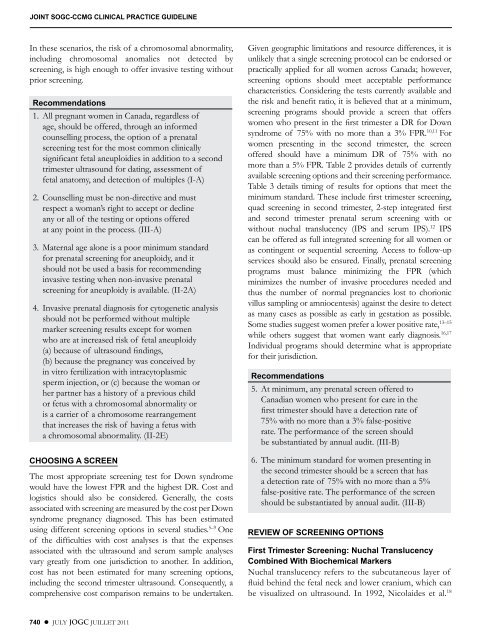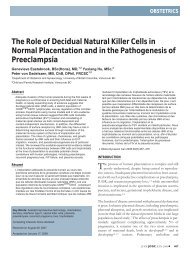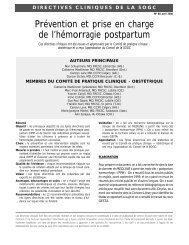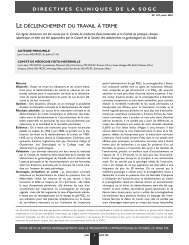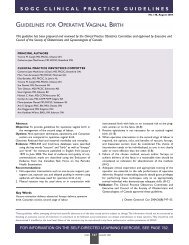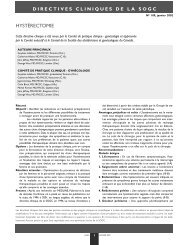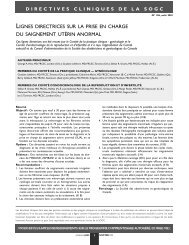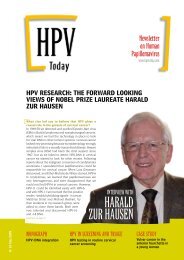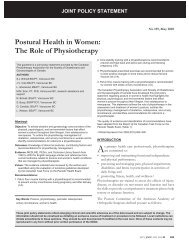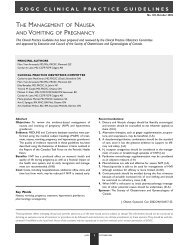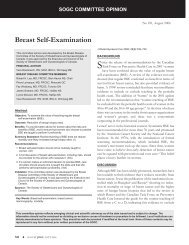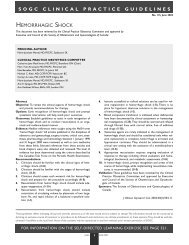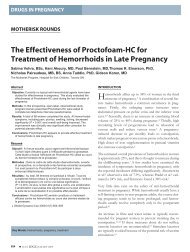Prenatal Screening for Fetal Aneuploidy in Singleton ... - SOGC
Prenatal Screening for Fetal Aneuploidy in Singleton ... - SOGC
Prenatal Screening for Fetal Aneuploidy in Singleton ... - SOGC
You also want an ePaper? Increase the reach of your titles
YUMPU automatically turns print PDFs into web optimized ePapers that Google loves.
JOINT <strong>SOGC</strong>-CCMG CLINICAL PRACTICE GuIDELINE<br />
In these scenarios, the risk of a chromosomal abnormality,<br />
<strong>in</strong>clud<strong>in</strong>g chromosomal anomalies not detected by<br />
screen<strong>in</strong>g, is high enough to offer <strong>in</strong>vasive test<strong>in</strong>g without<br />
prior screen<strong>in</strong>g.<br />
Recommendations<br />
1. All pregnant women <strong>in</strong> Canada, regardless of<br />
age, should be offered, through an <strong>in</strong><strong>for</strong>med<br />
counsell<strong>in</strong>g process, the option of a prenatal<br />
screen<strong>in</strong>g test <strong>for</strong> the most common cl<strong>in</strong>ically<br />
significant fetal aneuploidies <strong>in</strong> addition to a second<br />
trimester ultrasound <strong>for</strong> dat<strong>in</strong>g, assessment of<br />
fetal anatomy, and detection of multiples (I-A)<br />
2. Counsell<strong>in</strong>g must be non-directive and must<br />
respect a woman’s right to accept or decl<strong>in</strong>e<br />
any or all of the test<strong>in</strong>g or options offered<br />
at any po<strong>in</strong>t <strong>in</strong> the process. (III-A)<br />
3. Maternal age alone is a poor m<strong>in</strong>imum standard<br />
<strong>for</strong> prenatal screen<strong>in</strong>g <strong>for</strong> aneuploidy, and it<br />
should not be used a basis <strong>for</strong> recommend<strong>in</strong>g<br />
<strong>in</strong>vasive test<strong>in</strong>g when non-<strong>in</strong>vasive prenatal<br />
screen<strong>in</strong>g <strong>for</strong> aneuploidy is available. (II-2A)<br />
4. Invasive prenatal diagnosis <strong>for</strong> cytogenetic analysis<br />
should not be per<strong>for</strong>med without multiple<br />
marker screen<strong>in</strong>g results except <strong>for</strong> women<br />
who are at <strong>in</strong>creased risk of fetal aneuploidy<br />
(a) because of ultrasound f<strong>in</strong>d<strong>in</strong>gs,<br />
(b) because the pregnancy was conceived by<br />
<strong>in</strong> vitro fertilization with <strong>in</strong>tracytoplasmic<br />
sperm <strong>in</strong>jection, or (c) because the woman or<br />
her partner has a history of a previous child<br />
or fetus with a chromosomal abnormality or<br />
is a carrier of a chromosome rearrangement<br />
that <strong>in</strong>creases the risk of hav<strong>in</strong>g a fetus with<br />
a chromosomal abnormality. (II-2E)<br />
CHOOSING A SCREEN<br />
The most appropriate screen<strong>in</strong>g test <strong>for</strong> Down syndrome<br />
would have the lowest FPR and the highest DR. Cost and<br />
logistics should also be considered. Generally, the costs<br />
associated with screen<strong>in</strong>g are measured by the cost per Down<br />
syndrome pregnancy diagnosed. This has been estimated<br />
us<strong>in</strong>g different screen<strong>in</strong>g options <strong>in</strong> several studies. 5–9 One<br />
of the difficulties with cost analyses is that the expenses<br />
associated with the ultrasound and serum sample analyses<br />
vary greatly from one jurisdiction to another. In addition,<br />
cost has not been estimated <strong>for</strong> many screen<strong>in</strong>g options,<br />
<strong>in</strong>clud<strong>in</strong>g the second trimester ultrasound. Consequently, a<br />
comprehensive cost comparison rema<strong>in</strong>s to be undertaken.<br />
740 l JULY JOGC JUILLET 2011<br />
Given geographic limitations and resource differences, it is<br />
unlikely that a s<strong>in</strong>gle screen<strong>in</strong>g protocol can be endorsed or<br />
practically applied <strong>for</strong> all women across Canada; however,<br />
screen<strong>in</strong>g options should meet acceptable per<strong>for</strong>mance<br />
characteristics. Consider<strong>in</strong>g the tests currently available and<br />
the risk and benefit ratio, it is believed that at a m<strong>in</strong>imum,<br />
screen<strong>in</strong>g programs should provide a screen that offers<br />
women who present <strong>in</strong> the first trimester a DR <strong>for</strong> Down<br />
syndrome of 75% with no more than a 3% FPR. 10,11 For<br />
women present<strong>in</strong>g <strong>in</strong> the second trimester, the screen<br />
offered should have a m<strong>in</strong>imum DR of 75% with no<br />
more than a 5% FPR. Table 2 provides details of currently<br />
available screen<strong>in</strong>g options and their screen<strong>in</strong>g per<strong>for</strong>mance.<br />
Table 3 details tim<strong>in</strong>g of results <strong>for</strong> options that meet the<br />
m<strong>in</strong>imum standard. These <strong>in</strong>clude first trimester screen<strong>in</strong>g,<br />
quad screen<strong>in</strong>g <strong>in</strong> second trimester, 2-step <strong>in</strong>tegrated first<br />
and second trimester prenatal serum screen<strong>in</strong>g with or<br />
without nuchal translucency (IPS and serum IPS). 12 IPS<br />
can be offered as full <strong>in</strong>tegrated screen<strong>in</strong>g <strong>for</strong> all women or<br />
as cont<strong>in</strong>gent or sequential screen<strong>in</strong>g. Access to follow-up<br />
services should also be ensured. F<strong>in</strong>ally, prenatal screen<strong>in</strong>g<br />
programs must balance m<strong>in</strong>imiz<strong>in</strong>g the FPR (which<br />
m<strong>in</strong>imizes the number of <strong>in</strong>vasive procedures needed and<br />
thus the number of normal pregnancies lost to chorionic<br />
villus sampl<strong>in</strong>g or amniocentesis) aga<strong>in</strong>st the desire to detect<br />
as many cases as possible as early <strong>in</strong> gestation as possible.<br />
Some studies suggest women prefer a lower positive rate, 13–15<br />
while others suggest that women want early diagnosis. 16,17<br />
Individual programs should determ<strong>in</strong>e what is appropriate<br />
<strong>for</strong> their jurisdiction.<br />
Recommendations<br />
5. At m<strong>in</strong>imum, any prenatal screen offered to<br />
Canadian women who present <strong>for</strong> care <strong>in</strong> the<br />
first trimester should have a detection rate of<br />
75% with no more than a 3% false-positive<br />
rate. The per<strong>for</strong>mance of the screen should<br />
be substantiated by annual audit. (III-B)<br />
6. The m<strong>in</strong>imum standard <strong>for</strong> women present<strong>in</strong>g <strong>in</strong><br />
the second trimester should be a screen that has<br />
a detection rate of 75% with no more than a 5%<br />
false-positive rate. The per<strong>for</strong>mance of the screen<br />
should be substantiated by annual audit. (III-B)<br />
REVIEW OF SCREENING OPTIONS<br />
First Trimester <strong>Screen<strong>in</strong>g</strong>: Nuchal Translucency<br />
Comb<strong>in</strong>ed With Biochemical Markers<br />
Nuchal translucency refers to the subcutaneous layer of<br />
fluid beh<strong>in</strong>d the fetal neck and lower cranium, which can<br />
be visualized on ultrasound. In 1992, Nicolaides et al. 18


